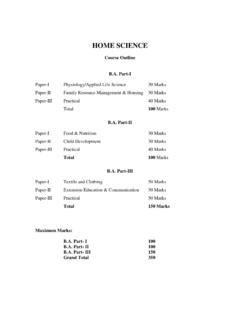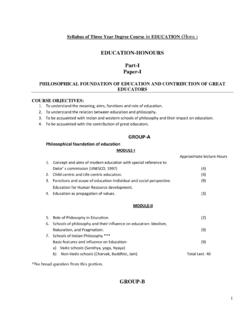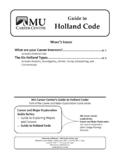Transcription of IMPACT 2002+: User Guide - Quantis
1 impact2002 +_UserGuide_for_vQ2 21_1 November2012 i IMPACT 2002+: User Guide Draft for version (version adapted by Quantis ) Prepared by: S bastien Humbert1* An De Schryver1 Xavier Bengoa1 Manuele Margni2 Olivier Jolliet3 * Corresponding author 1 Life Cycle Assessment Expert, Quantis , Lausanne, Switzerland 2 CIRAIG, cole Polytechnique de Montr al, Montr al QC, Canada 3 Center for Risk Science and Communication, Department of Environmental Health Sciences, School of Public Health, University of Michigan, Ann Arbor MI, USA IMPACT 2002+ is a methodology that was originally developed at the Swiss Federal Institute of Technology Lausanne (EPFL), Switzerland. It is now maintained and further developed by The IMPACT Modeling Team. November 1, 2012 Note: The difference between the versions (November 2012) and (March 2012) is an additional set of characterization factors improving the method s completeness.
2 All changes are documented in the Annex 5. The difference between the versions (updated by Quantis ) and are mainly that water turbined, water withdrawal and water consumption are added, and that aquatic acidification, aquatic eutrophication and water turbined are brought to the damage category ecosystem quality. Furthermore, climate change CFs are adapted with GWP for 100 year time horizon. The differences between the versions and are minor. They concern mainly 1 adaptation reflecting the update of the DALY used per case of cancer and non-cancer (respectively 13 and instead of and ) and 2 some format update (typos corrected, email addresses updated, font improved, references updated, etc.). impact2002 +_UserGuide_for_vQ2 21_1 November2012 ii A user Guide for the Life Cycle IMPACT Assessment Methodology IMPACT 2002+ (Jolliet et al.)
3 2003c) The paper (Jolliet et al. 2003c) and characterization factors ( impact2002 + ) can be downloaded at The supporting paper (Jolliet et al. 2003c) and (Pennington et al. 2005) can be obtained via the International Journal of Life Cycle Assessment ( or ) and the Environmental Science and Technology ( ) websites respectively. This user Guide is intended for supporting users to apply and interpret the LCIA methodology IMPACT 2002+ version impact2002 +_UserGuide_for_vQ2 21_1 November2012 iii Why a version adapted by Quantis and what has been adapted? The original IMPACT 2002+ version is not bringing all possible IMPACT categories to an endpoint and neglects some IMPACT categories which are increasingly demanded by industry. We see it necessary to create an adapted version for the following reasons: 1.
4 There is a strong demand of companies for analyzing climate change using IPCC 100 year instead of 500 year time horizon 2. Issues relating to water withdrawal, consumption and turbine are increasingly demanded by companies and should be considered 3. Eutrophication and acidification should be brought to endpoint level to add capacity to interpret results of ecosystem quality at endpoint without neglecting these important categories The following adaptations are made in (March 2012) and (November 2012): 1. Climate change CFs are adapted a 100 year time horizon 2. Water withdrawal, water consumption and water turbined are added 3. Aquatic acidification, aquatic eutrophication and water turbined are added at endpoint to the damage category ecosystem quality 4. Normalization factors are updated 5. (November 2012) New set of characterization factors (see Annex 5 for details) impact2002 +_UserGuide_for_vQ2 21_1 November2012 iv CONTENT ABSTRACT.
5 1 KEYWORDS .. 1 0. INTRODUCTION .. 2 STRUCTURE OF LCA .. 2 PRINCIPLES OF LCIA .. 2 1. IMPACT 2002+: GENERAL CONCEPT .. 3 IMPACT 2002+: GENERAL CHARACTERISTICS .. 4 UNITS .. 5 MIDPOINT 7 Human toxicity (carcinogenic and non-carcinogenic effects) .. 7 Respiratory effects (caused by inorganics) .. 8 Ionizing radiation .. 9 Ozone layer depletion .. 9 Photochemical oxidation .. 9 Aquatic ecotoxicity .. 9 Terrestrial ecotoxicity .. 10 Aquatic acidification .. 10 Aquatic eutrophication .. 10 Terrestrial acidification & nutrification .. 11 Land occupation .. 11 Water turbined .. 11 Global warming .. 12 Non-renewable energy .. 13 Mineral extraction .. 13 Water withdrawal .. 14 Water consumption .. 14 DAMAGE CATEGORIES .. 14 Human health .. 15 Ecosystem quality.
6 15 Transformation of units .. 15 Climate change .. 16 Resources .. 16 NORMALIZATION .. 16 2. CAUTIONS, LIMITATIONS AND INTERPRETATION .. 18 LINK BETWEEN LIFE CYCLE INVENTORY AND LIFE CYCLE IMPACT ASSESSMENT 18 Some relevant points to be aware of .. 18 Implementation in different types of software .. 18 HOW TO CHECK AND INTERPRET RESULTS? .. 18 UNCERTAINTIES .. 20 3. WEIGHTING .. 21 4. ABBREVIATIONS AND NUMERICAL HYPOTHESIS .. 22 ABBREVIATIONS AND GLOSSARY .. 22 NUMERICAL HYPOTHESIS .. 23 impact2002 +_UserGuide_for_vQ2 21_1 November2012 v 5. ACKNOWLEDGEMENTS .. 24 6. SOURCES .. 24 REFERENCES .. 24 INTERNET LINKS AND DOWNLOADABLE FILES .. 27 7. ANNEXES .. 29 ANNEX 1: NORMALIZATION FACTORS FOR THE MIDPOINT CATEGORIES .. 29 ANNEX 2: THE MIXING TRIANGLE .. 30 ANNEX 3: HOW TO USE IMPACT 2002+ IN DIFFERENT SOFTWARE?
7 31 ANNEX 4: HISTORICAL CHANGES OF IMPACT 2002+ .. 32 ANNEX 5: IMPACT 2002+ ADDED SUBSTANCES .. 33 impact2002 +_UserGuide_for_vQ2 21_1 November2012 1 Abstract The life cycle IMPACT assessment methodology IMPACT 2002+ (version adapted by Quantis ) proposes a feasible implementation of a combined midpoint/damage approach, linking all types of life cycle inventory results (elementary flows and other interventions) via several midpoint categories to several damage categories. For IMPACT 2002+ new concepts and methods have been developed, especially for the comparative assessment of human toxicity and ecotoxicity as well as inclusion of impacts from turbined water and assessment of water withdrawal and consumption. IMPACT 2002+ considers several midpoint categories, namely human toxicity carcinogenic effects, human toxicity non-carcinogenic effects (these two categories are sometimes grouped in one category: human toxicity), respiratory effects (due to inorganics), ionizing radiation, ozone layer depletion, photochemical oxidation, aquatic ecotoxicity, terrestrial ecotoxicity, aquatic acidification, aquatic eutrophication, terrestrial acidification/nutrification1, land occupation, water turbined, global warming, non-renewable energy consumption, mineral extraction, water withdrawal and water consumption.
8 All midpoint scores are expressed in units of a reference substance and related to the four damage categories human health, ecosystem quality, climate change, and resources. These four damage categories are expressed respectively in DALY, PDF m2 y, kg CO2-eq, and MJ. Normalization can be performed either at midpoint or at damage level. The IMPACT 2002+ methodology presently provides midpoint characterization factors, damage factors, normalized midpoint characterization factors and normalized damage factors for almost 1500 different life cycle inventory results, which can be downloaded at ( IMPACT 2002+ ) or ( IMPACT 2002+ , version adapted by Quantis , presented in the current document). Keywords IMPACT 2002+; life cycle assessment; life cycle IMPACT assessment; midpoint/damage approach; characterization/damage/normalization factors; human toxicity; carcinogenic; non-carcinogenic; respiratory effects; ionizing radiation; ozone layer depletion; photochemical oxidation; aquatic ecotoxicity; terrestrial ecotoxicity; aquatic acidification; aquatic eutrophication; terrestrial acidification/nutrification; land occupation; water turbined; global warming; non-renewable energy consumption; mineral extraction; water withdrawal; water consumption; human health; ecosystem quality; climate change; resources.
9 1 Note that some documents use the term nitrification instead of nutrification . Because the method Eco-indicator 99 uses the term nutrification we decided to use the same for simplification reasons. impact2002 +_UserGuide_for_vQ2 21_1 November2012 2 0. Introduction Structure of LCA According to ISO 14044 life cycle assessment (LCA) is a method for assessing the environmental aspects and potential impacts associated with a good or a service delivered, by: compiling an inventory of relevant input and output of a product system [ , the life cycle inventory (LCI)], evaluating the potential environmental impacts associated with those inputs and outputs [ , the life cycle IMPACT assessment (LCIA)] through the use of characterization factors (CFs), and interpreting the results of the inventory analysis and impacts assessment phases in relation to the objective of the study.
10 Principles of LCIA According to ISO 14040 and ISO 14044, life cycle assessment (LCA) is a method for assessing the environmental aspects and potential impacts associated with a good or a service delivered by the following: identify product system improvement opportunities and assist the prioritization of them, characterize or benchmark a product system and its unit processes over time, make relative comparisons among product systems based on selected category indicators, or indicate environmental issues for which other techniques can provide complementary environmental data and information useful to decision-makers. Thus LCIA methodologies aim to connect, as far as possible and desired, each LCI result (elementary flow or other intervention) to the corresponding environmental impacts by using CFs.





